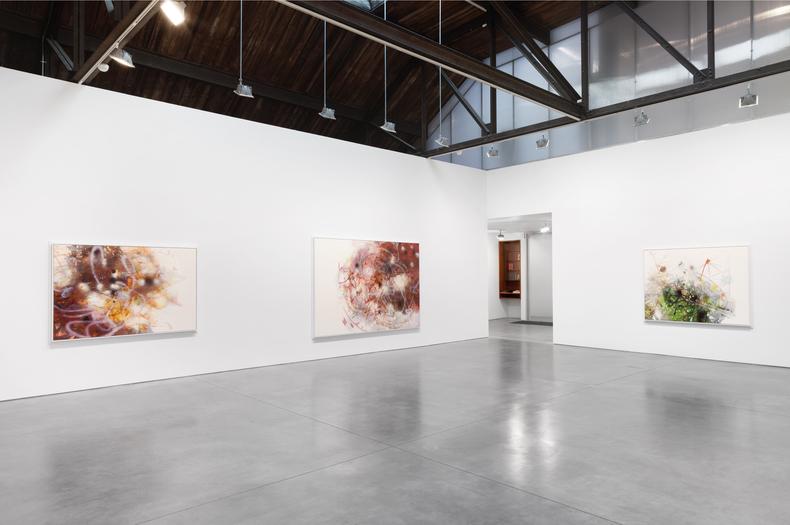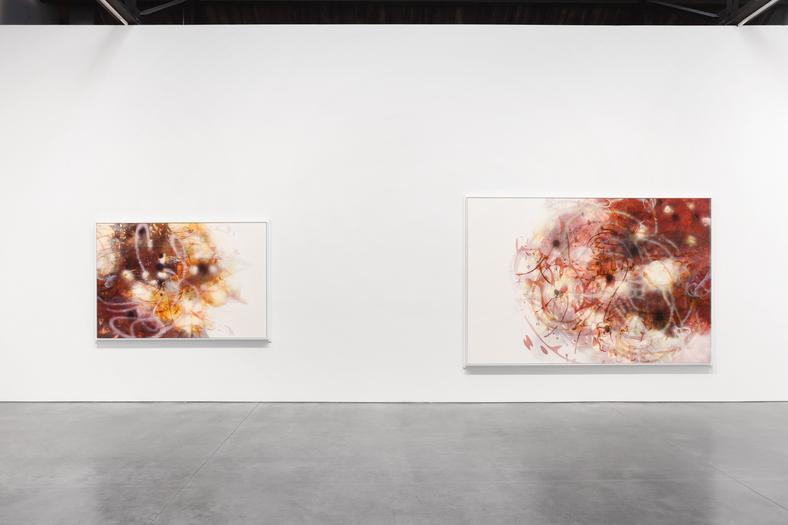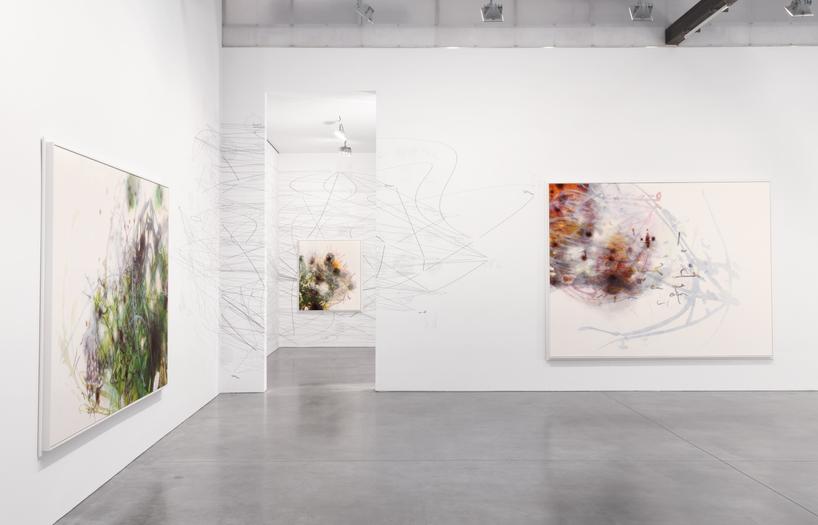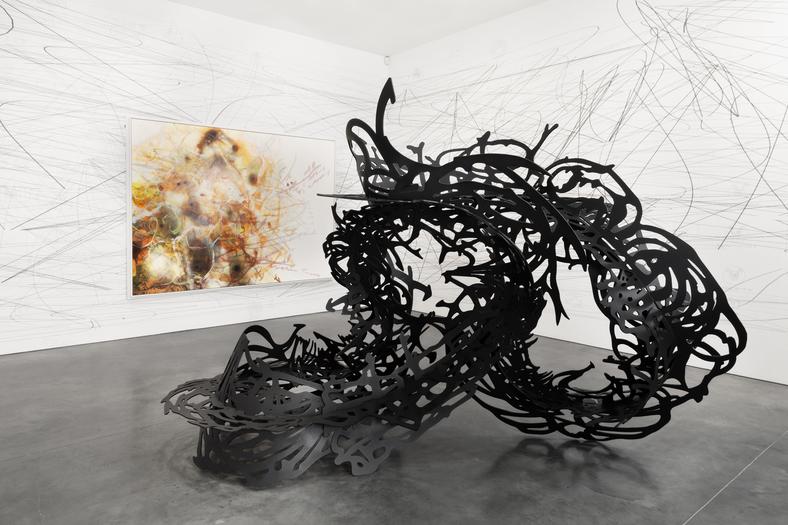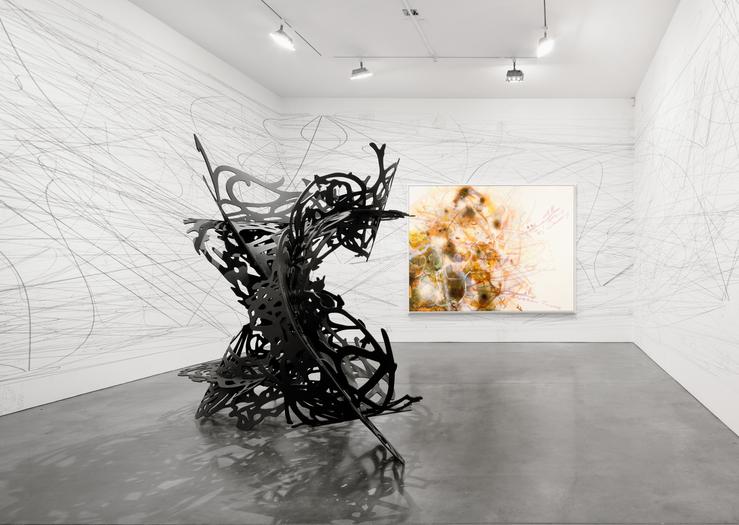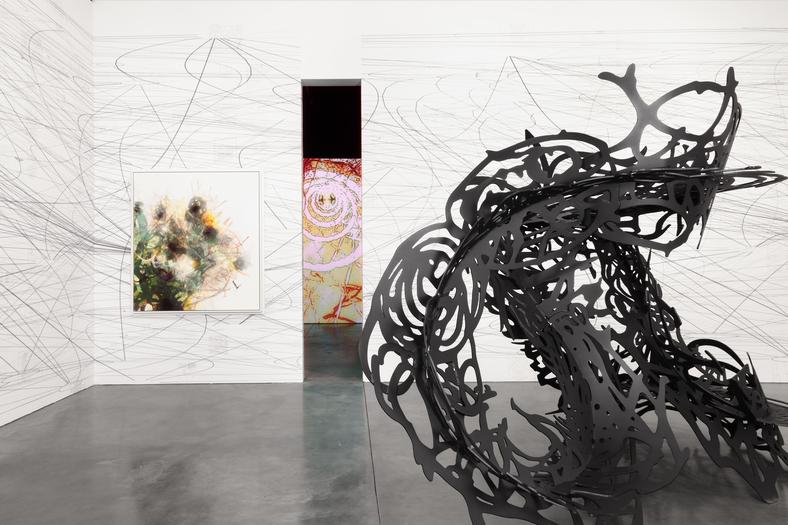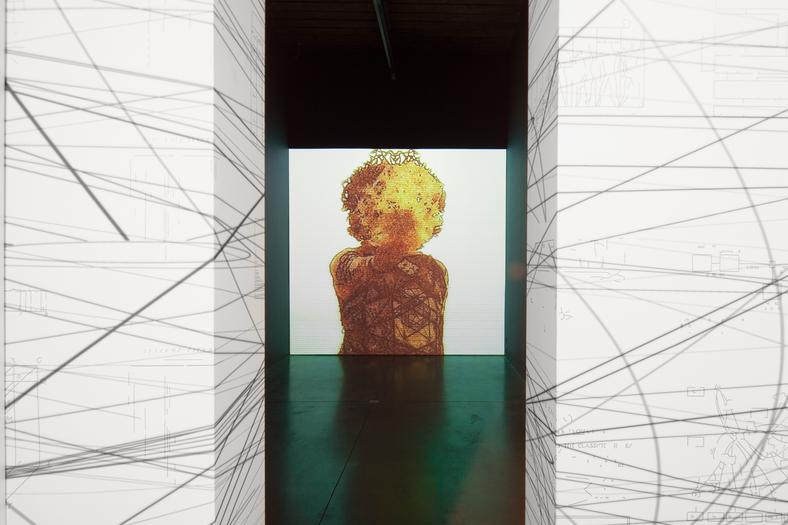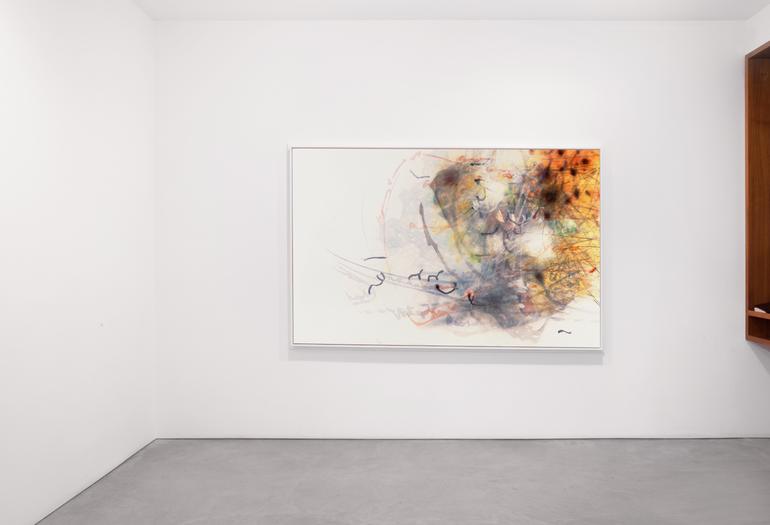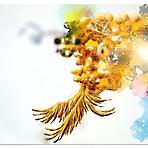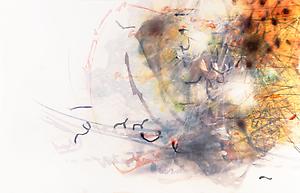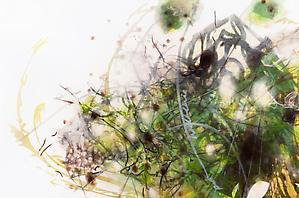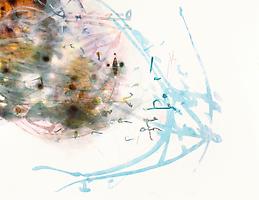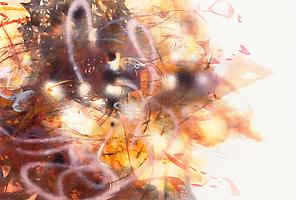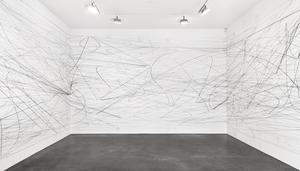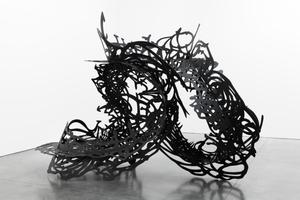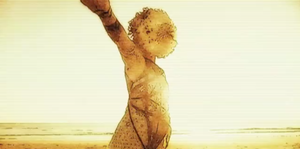Matthew Ritchie
Ten Possible Links
September 12 – October 22, 2014
Main Gallery
Opening reception: Thursday, September 11, 6:00 – 8:00pm
Andrea Rosen Gallery is delighted to present Ten Possible Links, Matthew Ritchie’s fifth solo-exhibition with the gallery. Weaving together four distinct projects, the exhibition embodies a comprehensive visual examination of diagrammatic thinking. Encompassing a wide range of mediums, Ritchie’s immersive installation - including painting, wall drawing, sculpture, sound and moving image - demonstrates the complexity and transient nature of information.
The ‘Ten Possible Links’ are a series of subtly vibrant and densely layered paintings that investigate the abstract imagery of Ritchie’s sculpture and cinematic landscapes through multiple diagrammatic and painterly gestures. Within an organic amassing of form, Ritchie creates densely layered eco-systems of information, retaining multiple styles of presentation. These canvases contain activity of complex natures, experiences, states, but their rich and saturated beauty also captures moments of stillness where something impossible to grasp is left un-grasped. The images are saturated with light and meaning, but bruised, as if the very process of examination is changing the physics of the forms described. Posed against a white ground, they could be emerging from what Paul Klee called ‘the interworld’, the dimensionless space of possibility.
The fragmentary diagrams within the paintings are all contained within the immersive wall installation The Temptation of the Diagram, an immense network of diagrams, collected, mapped, digitized, stripped of legible signs and reprocessed into essential gestures. Two accompanying source-books offer a guide for viewers through this vast investigation of the complex systems underlying the human creative and representational process and represent the origin and foundation of the works shown within its circuit. Confronted with the impossibility of comprehending the whole – what the artist describes as an oceanic feeling – Ritchie locates our sense of a vast universe without the abandonment of meaning. Together, the installation and the books describe generations of systems, ideas, interpretations, and reinforce the idea that it is the diagrammatic impulse that insistently connects, links and draws ideas together regardless of the possibility of ultimate comprehension. In doing so, Ritchie emphasizes the double constitution of painting and drawing as forms of ’hypostatic abstraction’ – a kind of abstraction that carries various levels of meaning.
Nested within this sprawling cerebral web of information is Night Drawing, a sculpture comprised of a matrix of interlocking segments designed to passively nest within one-another, creating a puzzle-like structure. Each segment employs the artist’s specific vernacular of form, and is drawn from the universe of diagrams that surround it. Mathematically based on modeling strange attractors explored in collaboration with architects Aranda\Lasch, the laser-cut aluminum construction takes two-dimensional form into a realm of three-dimensional drawing, forming a double moebius strip.
Expanding the space of drawing and painting into the realm of the moving image, Ritchie’s hyper-saturated film, Monstrance, traces an abstract and romantic narrative of past, present and future, as he mixes live performance footage and animation for the first time in his practice. Cut to a polyphonic choral score composed and performed by Ritchie’s long-standing collaborator Bryce Dessner, the film features singer Shara Worden as a masked oracle, presiding over a mythic, or post-post apocalyptic seascape. Created to be exhibited within a longshoreman’s chapel in Boston as part of his current residency at the ICA Boston, the film contains within its landscapes and choreographed gestures subtle diagrams and information that make visible the greater network of links underlying his practice.
Over the last seven years, through substantial cross disciplinary collaborations, Ritchie has consciously extended his own projects to explore the possibility of shared systems, aggregations and collaborations in contexts as diverse as opera, contemporary music, architecture, horticulture, urban design, theology and science through endeavors, both collaborative and intimate, to concretize and realize ephemeral and intangible theories of information and time. This exhibition proposes a further step, the re-integration of these diverse practices into a network of connections, a shared sea of information that retains its distinct properties in a state of superposition. In ‘Superposition and Field’, recently published by MIT press, Ritchie writes, “not only are ‘form’ and ‘contentʼ the same thing, namely information, but they are super-positionable and therefore do not enjoy any inherent oppositions at any scale.” ‘Ten Possible Links’ specifically refers to a navigational diagram by the philosopher Graham Harman that describes this aspect of what he calls ‘the quadruple object’ and is the subject of an essay by Ritchie in the forthcoming ‘Realism, Materialism, Art’ published by Sternberg Press and Bard CCS. In the essay Ritchie writes: “Over the last two centuries, the diagram has become the essential mechanism for our collective efforts to articulate and negotiate an almost impossible circumstance: reality itself. It embodies our interest in humanity as a directed and limited quantity, one we all have a vested interest in understanding and extending to the very limits of our abilities.” For Ritchie, acknowledging our incapability of grasping the totality of the universe is not simply a reason to let go, but also the vital force that compels investigation.
Matthew Ritchie was born in 1964. Ritchie is currently subject of an 18-month interdisciplinary residency at the Institute of Contemporary Art, Boston which encompasses several major works and will activate the entire museum through installation, sound performance and video. A new molecular sculpture garden for the Food and Drug Administration, Silver Spring, Maryland will open on October 1, 2014 and a 25,000 square foot site-specific rooftop drawing for the Buena Vista building in Miami, visible from the Design District Event Space designed by Aranda\Lasch, will open for Design Miami on December 1, 2014. His work has been shown in numerous exhibitions worldwide, including the Whitney Biennial, the Sydney Biennial, the São Paulo Biennial, the Venice Architecture Biennale, the Seville Biennale, and the Havana Bienal, and is in the permanent collections of the Museum of Modern Art, Institute of Contemporary Art, Boston, Guggenheim Museum, Whitney Museum of American Art, San Francisco Museum of Modern Art, and other institutions worldwide, including a permanent large-scale installation at the Massachusetts Institute of Technology.
For media inquiries please contact Lance Brewer at l.brewer@rosengallery.com or Jennifer Joy, Sutton PR, at jen@suttonpr.com
Matthew Ritchie
Published in conjunction with the project Matthew Ritchie: Remanence, an interdisciplinary 18-month artist residency from 2013 to 2014, organized by Jenelle Porter, Mannion Family Senior Curator, with John Andress, Associate Director of Performing Arts, and Gabrielle Wyrick, Associate Director of Education.
Matthew Ritchie: More Than The Eye
Acclaimed in the art world for his room-size installations of paintings, sculpture, and digital projections, Matthew Ritchie’s work investigates architecture and the dynamics of culture. Named by Time magazine in 2001 as one of 100 innovators for the new millennium, his rich work draws from subjects as diverse as ancient myth and medieval alchemy to cutting-edge physics and contemporary politics. This artist-designed book will explore Ritchie’s large-scale artistic "interventions" in buildings designed by Morphosis among others, including the Guggenheim Museum and MIT.
Publisher: Rizzoli (November 25, 2008)
ISBN-10: 0847831086
ISBN-13: 978-0847831081
Matthew Ritchie: The Morning Line
Published by Moderne Kunst Nürnberg
Edited Eva Ebersberger, Daniela Zyman. Preface by Francesca von Habsburg.
Text by Benjamin Aranda, Brandon LaBelle, Helene Furján, Chris Lasch, Tony Myatt, Hans Ulrich Obrist, Matthew Ritchie, Roland Schöny, Mark Wasiuta.
Situated at the interaction of art, architecture, music, mathematics, cosmology and science, Matthew Ritchie's "The Morning Line" is a 33-foot high sound pavilion, constructed in aluminum and conceived in part as a successor to Edgard Varèse and Le Corbusier's pavilion for the 1958 World's Fair, and Fritz Bornemann's Expo '70 Pavilion. Designed in collaboration with New York-based architects Aranda Lasch, the Arup Advanced Geometry Unit and the Music Research Centre of York University, the structure was inspired by the cosmological theories of Paul Steinhardt and Neil Turok, and offered a sonic environment in which newly commissioned works by well-known musicians were performed. This survey of the project includes a book containing Todd Eberle's photographs of the structure, a poster, a newspaper and a red vinyl LP with music by contemporary electronica musicians such as Alexej Borisov, Tommi Grönlund, Petteri Nisunen, Christian Fennesz, Carsten Nicolai, Zsolt Olejnik, Finnbogi Petursson, Franz Pomassl, Terre Thaemlitz and Zavoloka.
Publisher: Moderne Kunst Nürnberg; Box edition (April 30, 2012)
ISBN-10: 3869842423
ISBN-13: 978-3869842424
The Morning Line
Edited by Eva Ebersberger, Daniela Zyman.
Text by Caroline A. Jones, Peter Weibel, Benjamin Aranda, Chris Lasch, Mark Wasiuta, Bryce Dessner, Florian Hecker, Tony Myatt.
Extensive documentation of the worlds first traveling semasiographic structure; a collaborative environment conceived by Matthew Ritchie and designed with architects Aranda/Lasch, musician Bryce Dessner and scientist Paul Steinhardt.
Publisher: Walther Konig (February 1, 2009)
ISBN-10: 3865605664
ISBN-13: 978-3865605665
Matthew Ritchie: Proposition Player
In 1995, British artist Matthew Ritchie embarked on an extraordinary undertaking: he set out to tell the story of everything, from the Big Bang onward. His tale was to be told in paintings and drawings through a core group of 49 characters drawn from sources as diverse as mythology, quantum physics, alchemy, gambling, biblical tales, and pulp fiction. With Proposition Player, Ritchie's first major solo museum exhibition and accompanying catalogue, his narrative has reached a "climax, collapse, and crisis"--the story has morphed into a game and Ritchie has created a veritable information casino. Accompanying the paintings and drawings for which the artist is internationally known are works in new media, including a 100-foot-long three-dimensional drawing, an interactive craps table with digital animation that invites viewers to roll the dice for the future of the universe, an enormous rubble floor mosaic that invites viewers to walk into the heart of the piece, and a deck of cards featuring Ritchie's cast of characters.
Publisher: Contemporary Arts Museum (January 31, 2004)
ISBN-10: 0936080841
ISBN-13: 978-0936080840
Matthew Ritchie: Incomplete Projects 01-07
Matthew Ritchie: Incomplete Projects 01-07 was originally published from 2000 to 2006 as seven separate volumes to record a diverse group of projects. Institutional acknowledgements and credits accompanied each volume. Half of each print run was preserved to be collected in this final edition.
Awards: Best of Category in Graphic Design, I.D. Magazine, 2007
Hardcover: 224 pages
Publisher: Wild Card Crew, in collaboration with the Museum of Contemporary Art, North Miami; Dallas Museum of Art; Artists Space; MIT; Parkett; Two Palms Press; and Portikus
Matthew Ritchie: Incomplete Projects 07
Catalogue published in conjunction with the exhibition "We Want to See Some Light," July 9 - August 21, 2005, at Portikus im Leinwandhaus, Frankfurt am Main. It is the seventh volume in a multi-part series titled Matthew Ritchie, Incomplete Projects.
Matthew Ritchie: Incomplete Projects 06
Published in conjunction with Two Palms Press, 2004. It is the sixth volume in a multi-part series titled Matthew Ritchie, Incomplete Projects.
Matthew Ritchie: Incomplete Projects 05
Catalogue published in conjunction with the permanent installation Games of Chance and Skill (2002), commissioned by the MIT Perecent for Art Program for the Albert and Barrie Zesiger Sports and Fitness Center on the Massachusetts Institute of Technology campus in Cambridge, Massachusetts. It is the fifth volume in a multi-part series titled Matthew Ritchie, Incomplete Projects.
Matthew Ritchie: Incomplete Projects 04
Catalogue published in conjunction with the Edition for Parkett 61, November 5, 2001:
MATTHEW RITCHIE
The Bad Need
2001
adhesive-backed vinyl and acrylic paint
36 x 41 inches (92.08 x 105.41 cm)
Edition of XVIII
Accompanied by a certificate of authenticity in the form of a signed and numbered artist's book.
Matthew Ritchie: Incomplete Projects 03
Catalogue published in conjunction with the Edition for Artists Space:
MATTHEW RITCHIE
Sea State One
2001
Four color hand printed, pigminted relief print on Somerset paper.
16 x 32 inches
(40.6 x 81.3 cm)
Edition of 70
Published by Two Palms Press
Accompanied by one copy of the artist's book Sea State One: Incomplete Projects 03, containing manipulated images from The New Place, 2001, commissioned for "010101: Art in Technological Times," by the San Francisco Museum of Modern Art, CA.
Matthew Ritchie: Incomplete Projects 02
Catalogue published for the exhibition "Concentrations 38: Matthew Ritchie," organized by the Dallas Museum of Art, and curated by Suzanne Weaver, January 23 - April 21, 2001. It is the second volume in a multi-part series titled Matthew Ritchie, Incomplete Projects.
Matthew Ritchie: Incomplete Projects 01
Catalogue published for the exhibition "Matthew Ritchie," organized by the Museum of Contemporary Art, North Miami, and curated by Bonnie Clearwater, March 31 - June 25, 2000. It is the first volume in a multi-part series titled Matthew Ritchie, Incomplete Projects.
The Father Costume
Behold a stunning world, composed largely of water, where clothing changes people's behavior and time itself can be worn and discarded like cloth. Witness a father who takes his two boys out to sea, in flight from some menace at home, thus launching their adventures in a strange and dangerous territory. Artist Matthew Ritchie's striking images blend scientific diagramming with vivid, colorful renderings of the apocalypse, while writer Ben Marcus's cold prose plumbs the inner workings of two boys caught out at sea with a father whose costumes grow increasingly menacing. In this collaborative work, Ritchie's and Marcus's shared obsessions of mythology, physics and ancient texts have produced a conjunction of text and image in which people themselves are merely costumes for the darker needs that drive them.
Published by Artspace Books
Hardcover, 6.25 x 8.25 in. / 90 pgs / 16 color
Publication date 5/2/2002
ISBN 9781891273032
Matthew Ritchie: The Big Story
Published on the occassion of the exhibition "Mythopoeia: Projects by Matthew Barney, Luca Buvoli and Matthew Ritchie," curated by Jill Snyder. Presented at the Cleveland Center for Contemporary Art, Cleveland, Ohio, February 12 - May 2, 1999.
Matthew Ritchie: Hard Way
Published in 1996 by Galerie Météo, Paris, Basilico Fine Arts, New York, and C/O - Atle Gerhardsen, Oslo
Three philosophers walk into a painting
2014
Oil and ink on linen
Framed Dimensions:
46 x 60 x 2 1/2 inches
(116.8 x 152.4 x 6.4 cm)
ARG# RM2014-004
Our promised rising
2014
Oil and ink on linen
62 x 94 x 2 1/2 inches
(157.5 x 238.8 x 6.4 cm)
ARG# RM2014-009
Objects and realism
2014
Oil and ink on linen
Framed Dimensions:
62 x 78 x 2 1/2 inches
(157.5 x 198.1 x 6.4 cm)
ARG# RM2014-007
Link of nature
2014
Oil and ink on canvas
Framed Dimensions:
78 x 116 x 2 1/2 inches
(198.1 x 294.6 x 6.4 cm)
ARG# RM2014-010
Three philosophers walk into a painting
2014
Oil and ink on linen
Framed Dimensions:
46 x 60 x 2 1/2 inches
(116.8 x 152.4 x 6.4 cm)
ARG# RM2014-004
A bridge, a gate, an ocean
2014
Oil and ink on canvas
Framed Dimensions:
94 x 120 x 2 1/12 inches
(238.8 x 304.8 x 5.3 cm)
ARG# RM2014-013
Home is the hangman
2014
Oil and ink on linen
Framed Dimensions:
58 x 84 x 2 1/2 inches
(147.3 x 213.4 x 6.4 cm)
ARG# RM2014-006
The red and the red
2014
Oil and ink on canvas
Framed Dimensions:
82 x 120 x 2 1/2 inches
(208.3 x 304.8 x 6.4 cm)
ARG# RM2014-011
The Temptation of the Diagram
2014
Printed phototex
Dimensions variable
Edition of 5, 1 AP
ARG# RM2014-015
Sensual objects
2014
Oil and ink on linen
Framed Dimensions:
60 x 54 x 2 1/2 inches
(152.4 x 137.2 x 6.4 cm)
ARG# RM2014-005
Command and control
2014
Oil and ink on canvas
Framed Dimensions:
84 x 112 x 2 1/2 inches
(213.4 x 284.5 x 6.4 cm)
ARG# RM2014-012
Night Drawing
2014
Powder coated aluminum
125 x 82 x 84 inches (317.5 x 208.3 x 213.4 cm)
10'5" x 6'10" x 7' feet
Edition of 1, 1 AP
ARG# RM2014-014
Monstrance
2014
Single-channel video installation
Dimensions may vary with installation
Edition 1 of 3 1 AP
ARG# RM2014-026


